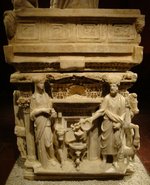In 2024 the Museum was closed for restoration following the earthquakes of 2023.
Antakya Archaeological Museum is one of the finest museums in all Turkey and on its own justifies a detour to the city. Its most important exhibits are the series of magnificent mosaics collected together from villas in Daphne (Harbiye), Seleuceia-in-Pieria and even Tarsus. These inevitably scoop all the publicity but the museum also contains fine, locally discovered exhibits dating back to Hittite times.
As you enter the museum two rooms on the left contain a splendid white marble sarcophagus of the Sidamara type associated with Central Anatolia and the finds, many of them gold, from inside it. These sarcophagi usually date from 160 to 270, and were carved in advance, with only the faces of the deceased couple reclining on the top being added later; in this case that never happened. The sides are lavishly carved with scenes of (?). It was discovered during excavations for an apartment block in 1993.
Amongst the most interesting mosaics are three small ones grouped together in a room dominated by
 a statue of the Emperor Lucius Verus from (?) . The Evil Eye mosaic shows a dog, duck and scorpion attacking an eye. Beside them the Greek word “KAICY” means “and the same to you”. People placed mosaics like this near the entrance to their home in an attempt to ward off the evil eye. Nearby, another “KAICY” mosaic shows a hunchback whose outsize genitals were presumably thought suitably scary. The third shows a black fisherman in pith helmet and loincloth whose life story can only be imagined.
a statue of the Emperor Lucius Verus from (?) . The Evil Eye mosaic shows a dog, duck and scorpion attacking an eye. Beside them the Greek word “KAICY” means “and the same to you”. People placed mosaics like this near the entrance to their home in an attempt to ward off the evil eye. Nearby, another “KAICY” mosaic shows a hunchback whose outsize genitals were presumably thought suitably scary. The third shows a black fisherman in pith helmet and loincloth whose life story can only be imagined.
On the wall of a connecting room is the Buffet Mosaic, an exquisite piece that depicts local foods and cooking utensils.
The most important room of all is carpeted with the magnificent Yakto Mosaic, a fifth-century piece from Daphne which graphically depicts scenes from the hunt.

